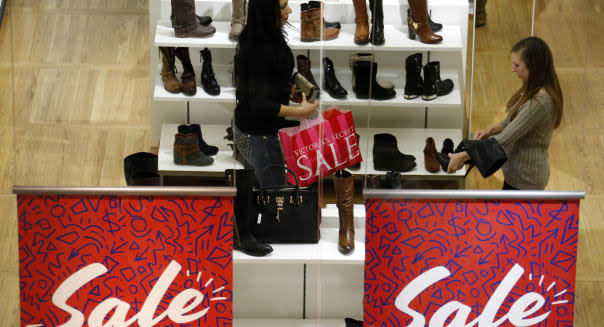Consumer Spending Rising Solidly; Manufacturing Still Weak

By Lucia Mutikani
WASHINGTON -- U.S. consumer spending grew at a fairly healthy pace over the past two months, but factory production slipped in August, providing the Federal Reserve a mixed picture of the economy ahead of a rate-setting meeting later this week.
The Commerce Department said Tuesday that retail sales excluding automobiles, gasoline, building materials and food services increased 0.4 percent in August after an upwardly revised 0.6 percent increase in July.
These so-called core retail sales, which correspond closely to the consumer spending component of gross domestic product, provided the latest sign of sturdy economic momentum and suggested the recent stock market sell-off had little immediate impact on U.S. household spending.
%VIRTUAL-pullquote-Today's data are positive news for final demand in the third quarter and should give the Fed more confidence in the spending outlook.%A separate report from the Federal Reserve, however, showed manufacturing output fell a sharper-than-expected 0.5 percent as auto production slid, after a rise of 0.9 percent in July.
Excluding autos, factory output was unchanged.
Investors pinned their response on the general firm spending figures. U.S. stocks opened higher, the dollar strengthened against a basket of currencies, and prices for U.S. government bonds fell, sending their yields higher.
"Today's data are positive news for final demand in the third quarter and should give the Fed more confidence in the spending outlook," said Laura Rosner, an economist at BNP Paribas in New York, referring to the retail sales data.
Signs of sustained strength in the economy could encourage the U.S. central bank to raise benchmark overnight interest rates from near zero. The Fed's policy-setting committee meets on Wednesday and Thursday against the backdrop of a tightening U.S. labor market, low inflation and slowing global growth.
U.S. financial markets have sharply dialed down expectations of a rate hike in the wake of the recent volatility in global equity markets. They are now pricing in a 25 percent probability that the Fed will announce a rate hike this week.
Data ranging from employment to housing have suggested the U.S. economy retained most of its momentum from the second quarter, when output expanded at a 3.7 percent annual pace.
The manufacturing sector, however, has been struggling, faced with the headwinds of a strong dollar, slack economies oversees and lower oil prices.
A third report Tuesday showed factory activity in New York state contracted in September for a second straight month.
Auto Sales Rise, but Production Down
Overall retail sales rose 0.2 percent last month as strong gains in auto sales were offset by a 1.8 percent drop in the value of sales at service stations as gasoline prices declined.
%VIRTUAL-WSSCourseInline-876%Receipts at auto dealerships rose 0.7 percent last month after rising 1.3 percent in July. Sales at clothing stores were up 0.4 percent, while receipts at building materials and garden equipment stores were down 1.8 percent. Sales at furniture stores fell 0.9 percent.
There were sales increases for online retailers, restaurants and bars, sporting goods and hobby stores, and electronics and appliance outlets.
The general bright news on spending was tempered by the soft factory data.
The Fed said auto and auto-part production contracted 6.4 percent last month, reversing much of the strong gains registered in July.
A drop in mining production combined with the drop in factory output to leave overall industrial production down 0.4 percent during the month, despite higher output for utilities.
-Dan Burns contributed reporting.
%VIRTUAL-WSSCourseInline-876%
